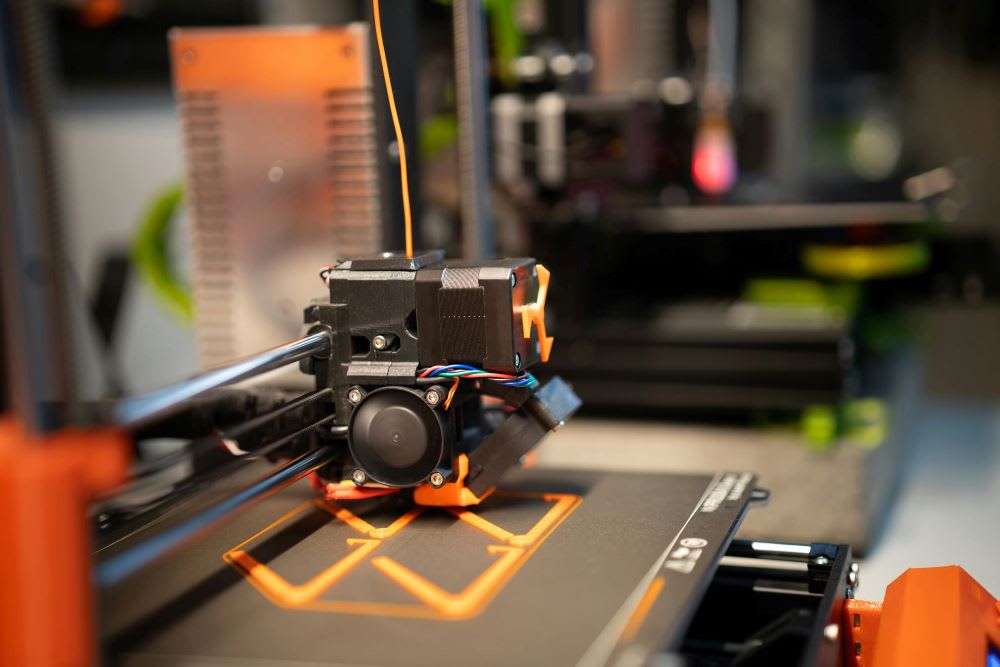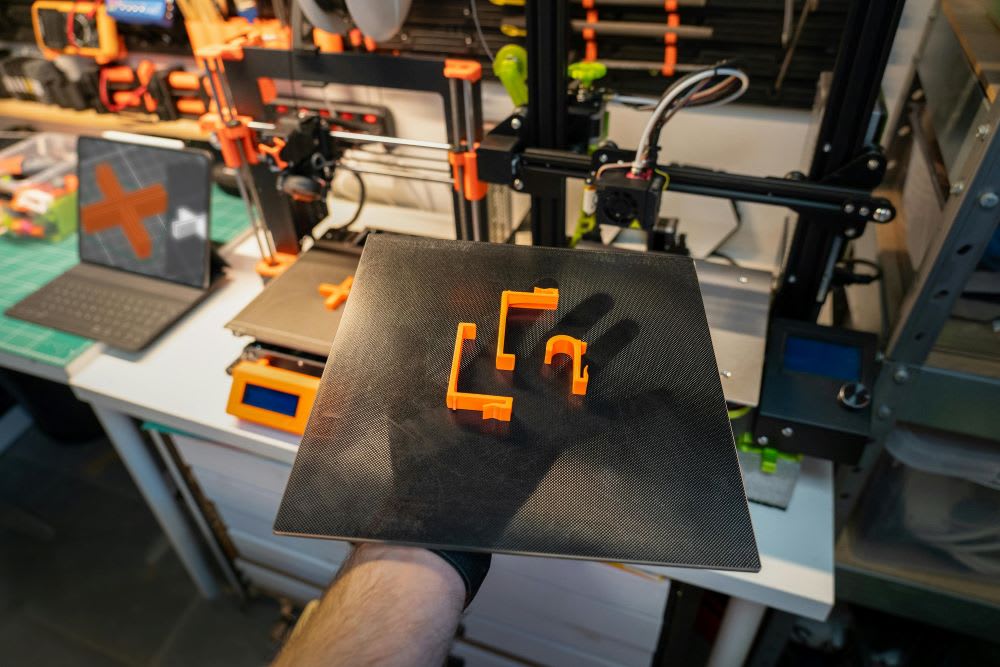- Published 25 Mar 2024
- Last Modified 25 Mar 2024
- 7 min
Understanding 3D Printing Materials for Commercial Use
3D printing has revolutionised manufacturing as a whole. Learn how to pick the right types of 3D printer filament to meet your commercial needs.

The impact of 3D printing across various industries in Australia and worldwide cannot be overstated. From revolutionising production processes to enhancing prototyping and fostering innovation, 3D printing has become a key fixture of modern manufacturing. In Australia alone, industries ranging from healthcare to automotive have embraced 3D printing for its ability to streamline production, reduce costs, and accelerate innovation.
However, the success of these ventures lies not just in the printers themselves but in the materials they use. Each type of 3D printer filament offers unique properties and capabilities, making the choice of 3D printer filament a pivotal decision in the 3D printing process. Understanding the diverse range of 3D printing materials available is thus crucial to maximising the potential of this transformative technology, particularly for popular types such as PLA filament and ABS filament.

Exploring 3D Printing Filaments
In the vast universe of 3D printing, a diverse array of materials beckons innovators and manufacturers alike, offering a broad spectrum of properties to suit a myriad of applications.
At the forefront of this array, PLA (Polylactic Acid) and ABS (Acrylonitrile Butadiene Styrene) filaments emerge as the most commonly utilised materials, each heralded for their distinct characteristics and versatility. Yet, the exploration of 3D printing filaments does not end with PLA and ABS. The industry offers a fascinating array of lesser-known materials, each tailored to specific needs and challenges.
PETG (Polyethylene Terephthalate Glycol), for example, combines the ease of printing found in PLA with the strength and durability closer to ABS without the same level of environmental impact. TPU (Thermoplastic Polyurethane) introduces flexibility and shock absorption, ideal for creating parts that require bending or sustained physical stress.
Moreover, speciality filaments infused with materials such as carbon fibre, wood, metal, or glow-in-the-dark additives open new avenues for creativity and functionality. These advanced options extend the capabilities of 3D printing, allowing for the creation of parts with unique aesthetic qualities, enhanced structural integrity, or specific technical properties.
However, despite the plethora of materials available for 3D printing, PLA and ABS filaments still stand out as popular choices for their accessibility, durability, and unique properties. Here’s what to consider when selecting your desired 3D printing filament:
PLA Filament: Eco-friendly and Versatile
PLA filament is derived from renewable resources, such as cornstarch, making it a compostable and eco-friendly option favoured in Australia's increasingly green-conscious market. Its ease of use, low warping, relatively low melting point, and lack of toxic fumes emitted during printing also make it a go-to for intricate designs and consumer goods. This ease of use also translates into lower production times and costs, appealing to businesses aiming to merge sustainability with efficiency.
In fact, PLA filament shines in applications where detail, aesthetics, and environmental impact are paramount. Australian companies specialising in bespoke designs or limited-run products often prefer PLA for its fine detailing capabilities and smooth finish. Additionally, its lower melting point makes it suitable for use in schools and universities, supporting the education sector's growing interest in 3D printing technology.
ABS Filament: The Industrial Workhorse
On the other hand, ABS filament offers enhanced durability and heat resistance, making it the material of choice for industrial applications that demand toughness, such as in the creation of durable goods, functional PCB prototypes, automotive components, and other industrial-grade items.
Its ability to withstand higher temperatures and mechanical stress aligns well with the needs of Australia's robust industrial sector, from Perth's mining equipment manufacturers to Brisbane's technology startups. The resilience of ABS also makes it a preferred material for fabricating tools and fixtures in manufacturing processes, underscoring its role and potential in revolutionising Australia’s industrial sectors.
Choosing the Best Filament for Your Project
In the diverse Australian market, where consumer preferences and industrial requirements vary widely, understanding the strengths and limitations of different 3D printing materials is essential. Selecting the most appropriate 3D printer filament requires careful consideration of the project's needs, including durability, aesthetics, environmental impact, and post-processing requirements.
Emphasising the importance of trial and error, experimentation with various filaments is crucial to pinpointing the best material for specific applications. This approach is particularly relevant in Australia, where innovative projects and unique environmental conditions may influence material performance. Testing different 3D printing materials helps not only achieve the desired outcome but also push the boundaries of what can be created with 3D printing technology.
Enhancing Projects with Advanced 3D Printer Filament Options

While PLA and ABS are staples in the 3D printing world, other filament types like PETG, TPU, and specialty composites may be better suited to meet unique project challenges. These materials not only broaden the spectrum of achievable projects but also introduce novel properties such as enhanced flexibility, transparency, and superior mechanical strength, thus addressing the nuanced challenges of sophisticated designs.
Transitioning to these advanced materials, however, requires a nuanced understanding of print settings, bed preparation, and strategies to overcome common 3D printing hurdles. Here are some pivotal tips for elevating your print quality, irrespective of the complexity or the novelty of the filament used:
- Adjusting print settings: Each filament type has its optimal printing conditions. For instance, PETG generally requires a higher extruder temperature than PLA, lying somewhere between PLA and ABS temperatures, to achieve a balance between layer adhesion and structural integrity. Meanwhile, TPU, known for its flexibility, demands slower printing speeds to prevent clogging and ensure consistent extrusion. It's crucial to refer to the filament manufacturer's guidelines for recommended temperatures and speeds, and then fine-tune these settings based on trial prints.
- Bed preparation: The adhesion of the first layer is paramount for a successful print. This is especially true for materials like PETG, which might stick too well to certain surfaces, or TPU, which might struggle to adhere due to its flexibility. Using a glue stick, hairspray, or blue painter's tape on the print bed can improve adhesion for PLA and PETG, whereas a heated bed is often essential for ABS to minimise warping. The key is to ensure the print bed is clean and level, with the appropriate surface preparation for the filament in use.
- Addressing common challenges: Each filament presents unique challenges. PETG, for example, is prone to stringing, which can be mitigated by fine-tuning retraction settings. TPU, with its elasticity, requires careful handling to avoid tangling and extruder jams. For materials susceptible to moisture absorption, such as Nylon, storing the filament in a dry, airtight container with desiccants and drying it before use can significantly improve print quality. Additionally, incorporating a cooling fan for materials like PLA can enhance detail sharpness by rapidly cooling the extruded filament, whereas for ABS, maintaining a stable, warm environment reduces the risk of layer separation and warping.
As the 3D printing landscape continues to evolve, so too does the repertoire of available filaments. From the foundational PLA and ABS to innovative speciality materials, each filament type offers a unique set of properties designed to meet the diverse needs of creators, designers, and engineers.
Discover 3D printer filament made from leading brands at RS Australia, and get ready to unlock the full potential of 3D printing in design, manufacturing, and beyond. As a leading provider of industrial and electronic products in Australia – from AV cables to zip ties – we connect you to 750,000+ products from over 2,500+ partners so your equipment and operational needs are fulfilled as seamlessly as possible. Browse selected products and brands below or reach out to us for more information.
Popular 3D Printer Filament Brands
Ultimaker
Ultimaker has carved a niche in the 3D printing industry with its high-quality filaments, renowned for precision and seamless print compatibility. Their ecosystem of materials is designed for reliability and superior print performance, making Ultimaker a go-to for professionals and enthusiasts alike.